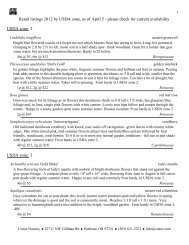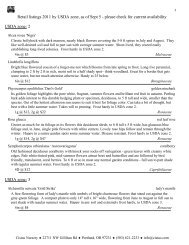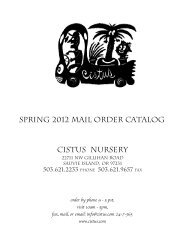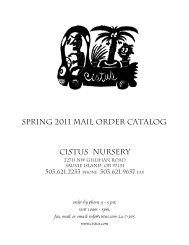Mail Order Catalog Fall 2010 - Cistus Nursery
Mail Order Catalog Fall 2010 - Cistus Nursery
Mail Order Catalog Fall 2010 - Cistus Nursery
You also want an ePaper? Increase the reach of your titles
YUMPU automatically turns print PDFs into web optimized ePapers that Google loves.
Agave ovatifolia [Sierra de Lampazos clone] whale's tongue agave<br />
One of the most beautiful century plants, found in the Sierra de Lampazos in the early 80s by the late great<br />
plantsman, Lynn Lowrey and only named in 2004 by agave-ist Greg Starr. Growing in a limited range of<br />
pinion/juniper/oak country above 8000 ft, the chalky blue rosettes, exceedingly wide and beautifully toothed, can<br />
reach over 5 ft in width giving the appearance of a much more tropical species. Has proven to be one of the best<br />
performers where cold and wet is experienced in winter and has, thus far, proven hardy to 0F, USDA zone 7, or<br />
even a bit lower. Sun to dappled shade; drainage is always a plus.<br />
$17.00<br />
$14.00<br />
9<br />
Agavaceae<br />
* Agave palmeri [Chiricahua Mtns., 6900' elev.] palmer agave<br />
A handsome agave, to 3 ft all x 4 ft wide, with stiff, blue-green leaves edged with curved, sharp, red-brown teeth<br />
and tipped with a long, sharp spine. Native to southeastern Arizona, southern New Mexico, and northern Mexico,<br />
this form originated in the Chiricahua Mountains of south eastern Arizona at higher than usual elevations. The<br />
flower stalks, produced in early spring after 5 years, bear pale, greenish yellow flowers followed by banana-like<br />
fruit. Plants offset, fortunately, as this a monocarpic species that dies after setting seed. Full sun with good<br />
drainage is best with only very occasional summer water. Frost hardy to 5F, mid USDA zone 7.<br />
Agavaceae<br />
Agave parrasana<br />
This Mexican species is most easily identified by its thick triangular leaves, beautifully marked blue-green in<br />
color, arranged in a striking rosette and edged with equally thick brown and white spines. Plants form low dense<br />
mounds, each rosette eventually measuring 2 ft x 2 ft and, in time, sending up 12 ft branched flower spikes of<br />
warm yellow blushed apricot. Best in mineral soil, sharp drainage, full sun. This represents a high elevation<br />
collection at over 8,500 ft that has thus far withstood between 0 and 10F, USDA zone 7, with overhead protection<br />
from excess winter moisture. Stunning pot plant or container specimen.<br />
$16.00<br />
Agavaceae<br />
Agave parryi (aff. var. couesii) SBHMPS 6725<br />
From one of our favorite places in Arizona, east of Prescott amid nolinas and ponderosa pines, this extremely<br />
hardy century plant grows in colonies of giant (nearly 2 ft), blue, artichoke-like rosettes. Its habitat is a cold<br />
climate where temperatures frequently drop below 0F and the ground is snow covered or frozen for long periods<br />
of time.These plants should be hardy to well below -10F, USDA zone 6. Although this population exhibits<br />
characteristics of both A. parryi and A. couesii, what we know for certain is that these beautiful blue plants are<br />
from the highest elevation we have ever found the species and should be exceedingly frost hardy with good air<br />
circulation, bright light and good drainage.<br />
$16.00<br />
Agavaceae<br />
Agave parryi (aff. var. couesii) SBHMPS 6728<br />
From the high ponderosa woods at over 8,000 ft between Jerome and Prescott, Arizona, where, in 1981, we first<br />
set our eyes upon this particular "patch" growing in light shade with beautiful, 24", blue "artichokes" and dozens<br />
of offsets spreading from the plants, seemingly in a race to get to a nearby clearing. Sometimes the reason the<br />
plants are brought into cultivation is simply because they are easy to propagate. This little agave is both beautiful<br />
and.... we can make more. The same culture as for other Agave parryi with dappled shade to bright light and<br />
fairly free drainage. This clone, however, should be exceedingly frost hardy to at least -10F, USDA zone 6,<br />
possibly colder. Should still be provided winter protection if grown in container below USDA zone 8.<br />
$17.00<br />
Agavaceae<br />
Spring <strong>2010</strong> <strong>Mail</strong> <strong>Order</strong> <strong>Catalog</strong> (* = new to mail order list)







